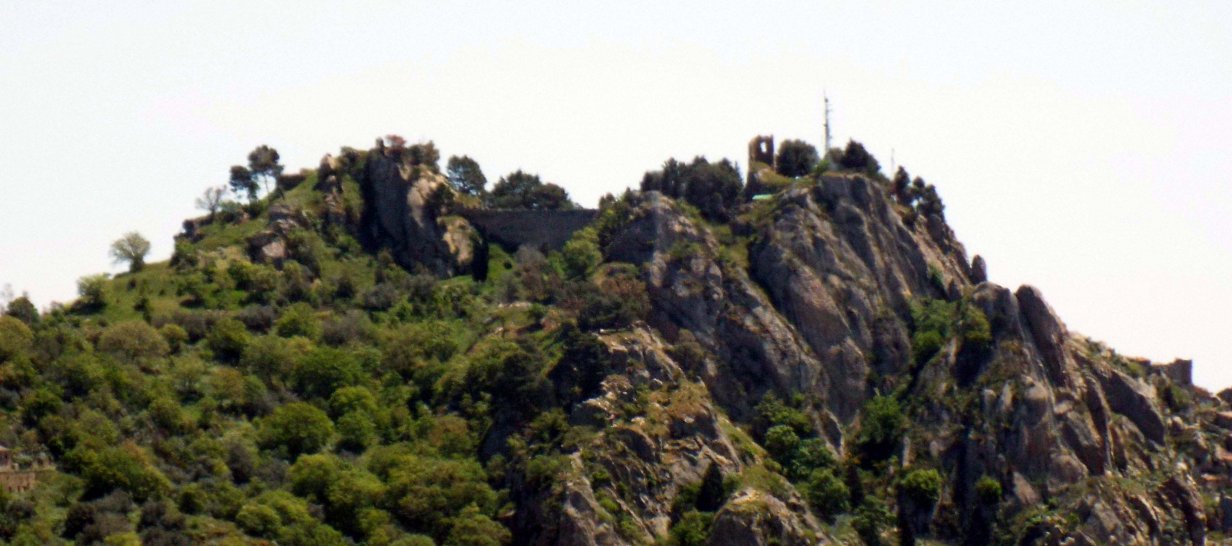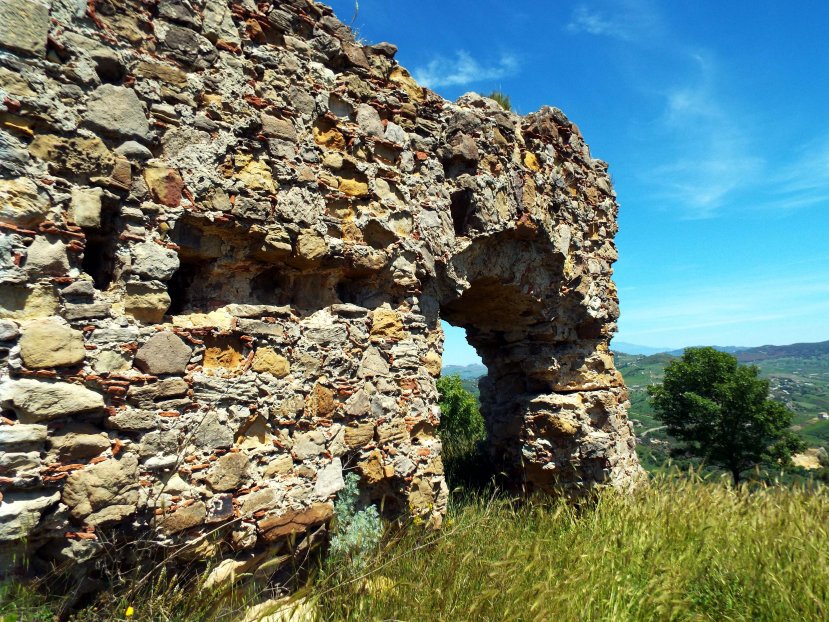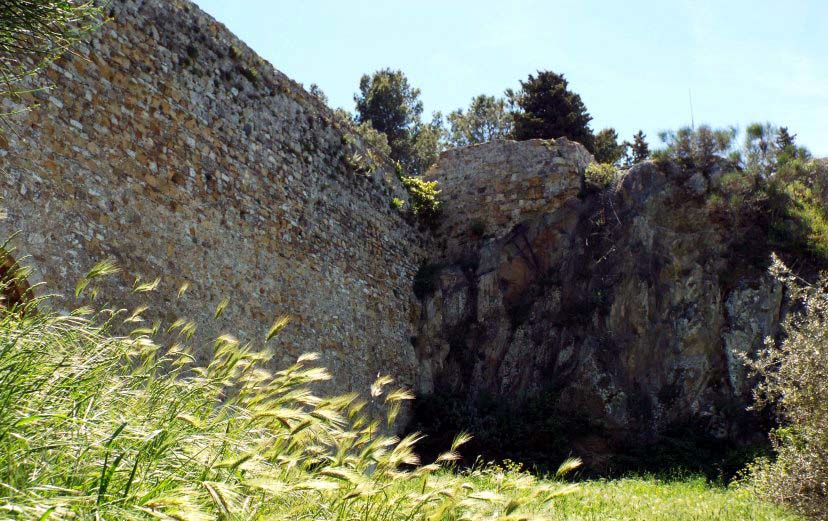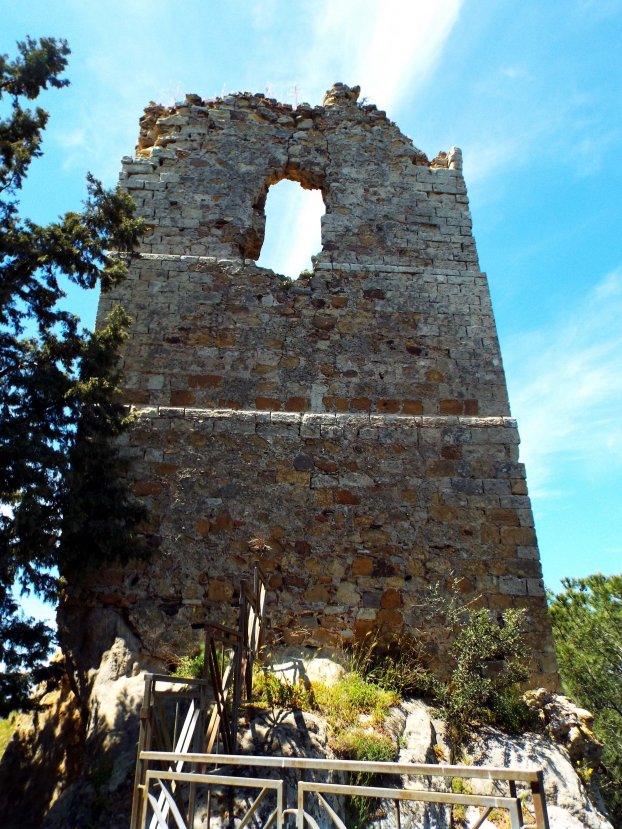Nicosia

Therefore, although a Lombardic district, there is no mention of action
at the castle when the revolts of 1160-61 shook the district and Butera and Piazza Armerina were attacked. Indeed, when the revolt of Messina shook
the kingdom in 1168, Nicosia was one of the places who promised
to send troops to the king to put down the insurrection. Nearly
100 years later in November 1254 the town and presumably the castle
rebelled against Peter Ruffo (d.1256+) when he was breaking the siege
of Enna.
In May
1272, when King Charles (d.1285) was
reorganising the defences of the island, his chancellor set the
garrison of the fortress to be 20 knights. This was an
exceptionally large force and shows the importance of the castle in the
interior of the island.
In mid September 1282, after the Vespers Revolt, King Peter (d.1285) stayed here on his march from
Trapani to Messina. Soon afterwards, the lord of the castle, Alaimo Lentini, captured Walter Caltagirone after he had seized Sperlinga castle.
The two had earlier been joint plotters in the Silician Vespers
from at least 1279 and now Lentini betrayed him to King Peter. In
1284 the Lady Machalda, the wife of
Alaimo, a main leader of the revolt, full of
jealousy for Queen Constance (d.1302), had herself, although in perfect
health, carried in a litter from Palermo
to Nicosia, simply to insult
the queen who was actually suffering ill health. If the tale
is to be believed, Machalda's litter, decked out in scarlet cloth, was
therefore carried on the shoulders of her husband's servants for a full
70 miles - or a good 4 days walk! As overlord of Nicosia,
Lentini employed one Master Garcia of Nicosia on treasonable
correspondence
with the king of France. For this Lentini's nephews did him
to death to unsuccessfully keep the treason secret. Alaimo was
sent to Catalonia, from where he never returned and his wife, Machalda
Scaletta, was imprisoned with her children in Messina castle in 1284. There her gay and immodest dress scandalised her jailers.
By the 1320s Nicosia was held by Michael Berga and Roger Vallono, but
it had come to James Chiaramonte by 1354, when he was allowed to mint
copper
coins there with his own image on them.
 Description
Description
Located on the highest rock in the city at 2,868' stands a curtain wall
forming a bridge between 2 castles on juxtaposed crags. It is
hard to
decide which castle is the outer ward. To the northeast is a rocky
crag with an outer defensive wall to the east. Within this is
another wall with an apparent inturned entrance to the northeast. Beside
this to the north may have been an internal rectangular
guardhouse. On the crag above this is the main keep, an
elongated structure with a possible round tower to the northwest.
This was entered via an ogival arch to the SE and has many Roman tiles
in the structure used for levelling.
 Beneath
the rock face and accessed by a modern path around the crag is
the Norman curtain linking the two sites. This is 262' long
and has a central ogival arch at its base on the north side and a
Romanesque one on its south side. Originally one of these was
said to be surmounted by a Norman coat of
arms. This high curtain was equally battlemented on both sides,
being as it was, the only link between the 2 halves of the site.
Again there are Roman tiles in the structure.
Beneath
the rock face and accessed by a modern path around the crag is
the Norman curtain linking the two sites. This is 262' long
and has a central ogival arch at its base on the north side and a
Romanesque one on its south side. Originally one of these was
said to be surmounted by a Norman coat of
arms. This high curtain was equally battlemented on both sides,
being as it was, the only link between the 2 halves of the site.
Again there are Roman tiles in the structure.
 On
the southwest side of the bridge, on its northern side, stands the remains
of the basement of a square guard tower made of fine small ashlar
blocks, similar to the keep high above it to the southwest. The tall
rectangular keep has largely
collapsed to the west although it was built directly onto the
rock. To the east the tower sinks a good storey down the
rockface. It has a basement and 1 proper storey above this.
The south face is made of fine, small ashlar blocks and there is the
featureless gap of a destroyed window on the top storey. This
side also has 2 external steps, one at first floor level and the other
at the window base. Similarly externally stepped towers exist at Kendal and Bamborough in the north of England. There are traces of a wallwalk and
battlements on the summit of the Nicosia tower.
On
the southwest side of the bridge, on its northern side, stands the remains
of the basement of a square guard tower made of fine small ashlar
blocks, similar to the keep high above it to the southwest. The tall
rectangular keep has largely
collapsed to the west although it was built directly onto the
rock. To the east the tower sinks a good storey down the
rockface. It has a basement and 1 proper storey above this.
The south face is made of fine, small ashlar blocks and there is the
featureless gap of a destroyed window on the top storey. This
side also has 2 external steps, one at first floor level and the other
at the window base. Similarly externally stepped towers exist at Kendal and Bamborough in the north of England. There are traces of a wallwalk and
battlements on the summit of the Nicosia tower.
The keep stands on
the northeast side of an northwest to southeast running battleship site, so typical of
Byzantine work, viz: Aci, Calatabianco, Castelmola, Castronovo, Cefala Diana, Rometta, Sperlinga, Taormina and Vicari. The walls are best preserved to the southeast and contain many Roman tiles.
Apparently this castle was known as Castelletto from the fourteenth
century family of that name which lived here. Apparently
there were once 3 towers here, a sundial and 2 cisterns. The church below has a decagonal tower.
Why not join me here and at other Sicilian
castles? Information on this and other tours can be found at Scholarly
Sojourns.
Copyright©2019
Paul Martin Remfry


 Description
Description Beneath
the rock face and accessed by a modern path around the crag is
the Norman curtain linking the two sites. This is 262' long
and has a central ogival arch at its base on the north side and a
Romanesque one on its south side. Originally one of these was
said to be surmounted by a Norman coat of
arms. This high curtain was equally battlemented on both sides,
being as it was, the only link between the 2 halves of the site.
Again there are Roman tiles in the structure.
Beneath
the rock face and accessed by a modern path around the crag is
the Norman curtain linking the two sites. This is 262' long
and has a central ogival arch at its base on the north side and a
Romanesque one on its south side. Originally one of these was
said to be surmounted by a Norman coat of
arms. This high curtain was equally battlemented on both sides,
being as it was, the only link between the 2 halves of the site.
Again there are Roman tiles in the structure. On
the southwest side of the bridge, on its northern side, stands the remains
of the basement of a square guard tower made of fine small ashlar
blocks, similar to the keep high above it to the southwest. The tall
rectangular keep has largely
collapsed to the west although it was built directly onto the
rock. To the east the tower sinks a good storey down the
rockface. It has a basement and 1 proper storey above this.
The south face is made of fine, small ashlar blocks and there is the
featureless gap of a destroyed window on the top storey. This
side also has 2 external steps, one at first floor level and the other
at the window base. Similarly externally stepped towers exist at Kendal and Bamborough in the north of England. There are traces of a wallwalk and
battlements on the summit of the Nicosia tower.
On
the southwest side of the bridge, on its northern side, stands the remains
of the basement of a square guard tower made of fine small ashlar
blocks, similar to the keep high above it to the southwest. The tall
rectangular keep has largely
collapsed to the west although it was built directly onto the
rock. To the east the tower sinks a good storey down the
rockface. It has a basement and 1 proper storey above this.
The south face is made of fine, small ashlar blocks and there is the
featureless gap of a destroyed window on the top storey. This
side also has 2 external steps, one at first floor level and the other
at the window base. Similarly externally stepped towers exist at Kendal and Bamborough in the north of England. There are traces of a wallwalk and
battlements on the summit of the Nicosia tower.